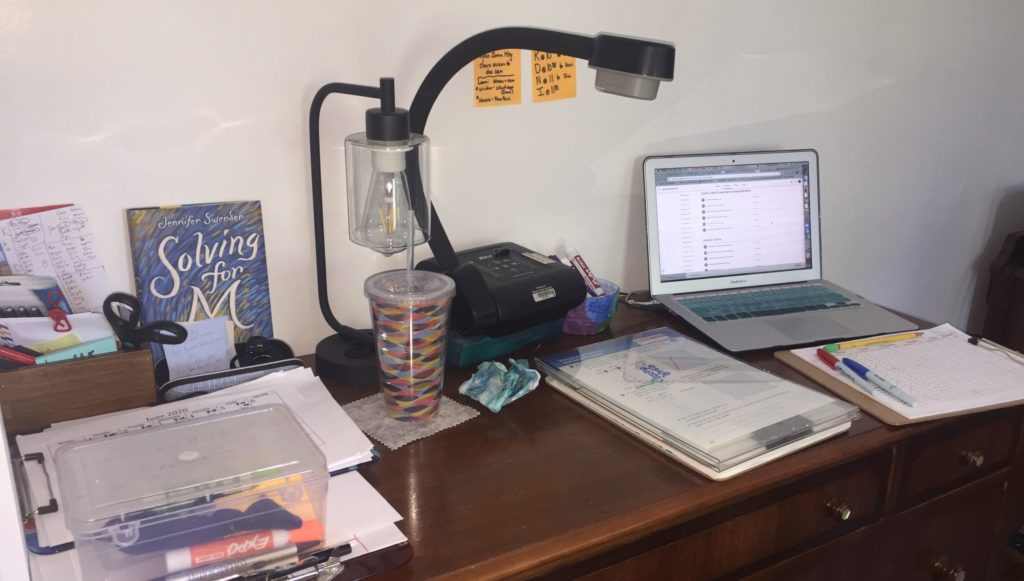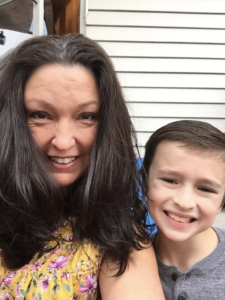
Veteran Boston Public Schools teacher, Ms. DiSarcina, gives us an inside look at one virtual school day
In the corner of Jenn DiSarcina’s home lies an ordinary wooden dresser. Adorned with packets of math lessons and boxes of markers, the dresser now functions as a modern teacher’s desk. A laptop running Zoom sits on its right corner. This is Ms. DiSarcina’s new classroom.
When Governor Baker officially closed school buildings for the remainder of the year in April, Boston Public Schools teachers braced for their more permanent realities. Many – like Ms. DiSarcina – had to learn to navigate new methods of reaching their students, while serving as full-time parents to their own children who are also at home.
 In between Zoom sessions with her class, Ms. DiSarcina provides guidance to her third-grade son, Sebastian. Their shared workspace allows him to easily ask for help when he needs it, but it also mimics the feeling of being back in a physical classroom. It’s another reminder of how the line between teacher and parent blurs for educators in the midst of the COVID-19 pandemic.
In between Zoom sessions with her class, Ms. DiSarcina provides guidance to her third-grade son, Sebastian. Their shared workspace allows him to easily ask for help when he needs it, but it also mimics the feeling of being back in a physical classroom. It’s another reminder of how the line between teacher and parent blurs for educators in the midst of the COVID-19 pandemic.
While the landscape is vastly different in an online setting, teachers have been working their hardest to provide students with a familiar structure to their school day – even offering extra support with individual students “after school.”
It can be difficult – nearly impossible – to find a substitute for the intangible benefits of teaching in a classroom. “I can’t see shoulders tense when a problem is too hard,” says Ms. DiSarcina. “I can’t see a sigh, or a pencil drop. I’m confident in what I can communicate to kids because of our relationship – I just worry that I’m missing so much still because I can’t read their body language.” But teachers like Ms. DiSarcina are doing whatever they can to get creative.
Instead of catching students in the hallways, she tracks them down virtually – sending a direct message on Remind, calling and texting parents, and sometimes enlisting the help of classmates who provide intel on their digital whereabouts.
Ms. DiSarcina does all this from that wooden dresser in the corner of her home. The setting may have changed, but teachers’ dedication to educating their students certainly hasn’t. She recently took her first full day off after ten weeks. “There’s so much to do and it’s so much harder to do it from a distance, but I want our kids to know that they can do this – they can do the hard things. I want them to feel like we did the best job we could through all of this as a class.”
There’s a lot that goes into remote learning. Ms. DiSarcina takes us “behind the scenes” of a virtual school day below.
Monday, May 18, 2020 – Ms. DiSarcina’s “Classroom” at the Eliot K-8 Innovation School
8:00 AM
Begin preview of 3rd grade work for my son, Sebastian, over breakfast. We talk through a plan for him to do the work, including his online time. This helps him organize, plan, and prioritize – and gives me insight on where I will need to support!
8:30 AM
Sebastian is working on his daily assignments, and I am answering parent emails as well as texting back and forth with my teaching team about some students we share and the work we need to accomplish this week. During this time, I try to get some more digitizing of lessons done so the weekends can start to have more of a family balance.
9:45 AM
Quick family conversation/review of the schedule. It’s a busy Zoom/Google Meets day for both Sebastian and I, and Google Calendar has saved the day! My son now knows how to keep the calendar tab open and click the links that don’t change every meeting, and where to look for the codes that do.
10:00 AM
First math class of four back-to-back! We try to keep the middle (grades 5-8) students in their content classes in two straight blocks so everyone feels like we are in school. Instead of going down the hall from class to class, we digitally pass them to the next Zoom Room.
As kids filter in, we start with a warm up called “Which One Doesn’t Belong?,” a math puzzle that sparks conversation, and justification because you can justify each option as not belonging for a different reason.
As the kids offer up their answers and reasoning, we have a routine of “updated telephone tag.” If a child is missing, I know who has their phone/snapchat/etc., and they contact the other student to make sure they are in class. A couple of students I used to text at 9:55 each morning, are now the first ones in! Sebastian sits right behind my desk, wanting the company of not only Mom but other students – even if they aren’t his classmates.
I pre-record the mini lessons for each day over the weekends. We have a couple students who still have connection issues, one student who has to be at the YMCA all week because their parent works in a hospital, and several other students who need to see the lesson more than once. It felt very awkward, in the beginning, to watch the kids watch me on a video but I am determined that whomever cannot make it has the same access to the learning as those who can!
During the video, I take attendance quickly to submit after classes, and send individual chat messages to students with either encouragement or reminders to get the previous day’s work turned in. Today during the 2nd block, I luckily had time to help Sebastian troubleshoot his Zoom for speech at his “school.” They meet twice a week for 30 minutes, and he heads off to another room so he can work and talk freely.
We then begin the day’s work together, and this is where the sweet spot lies. This is where we (sometimes) start to feel close to being back together. In the beginning (and still some days!) it felt very isolating and kids felt awkward answering. Some were being polite, following rules and raising their (physical) hands – which you can’t see if you have two to three Zoom screens of participants. We practiced raising our “blue Zoom hands” but their teacher still isn’t adept at writing student thinking, answering and asking questions…and keeping an eye on the participant list (which is often minimized because I want to see FACES).
We laugh a lot and I try to keep the tech challenges light and something to joke about. It helps all of us get through this, and hopefully promotes perseverance and having a sense of humor about things you can’t control.
Every half hour, we switch classes until (almost) all 91 students have had math. At the top of the last block, Sebastian lets me know he’s going to his room. His 3rd grade class has one of their twice-weekly Google Meets, and it’s always joyous chatter when they are all back together! A couple students stay on for a few minutes after the last block to finish up the work and ask questions.
Shortly after that, I check-in with my son about the progress in his 3rd grade work. The bulk will need to be done in the afternoon because he had two online sessions in the morning.
12:15 PM
I have a quick half-hour check in with my Admin to go over the agendas for the math and fifth grade team meetings this week. She shares updates from the district that they receive Friday evenings. We talk about a few students and families our team is focusing on right now, and discuss next steps as well.
12:45 PM
We take a pause and make lunch. One of the benefits of this situation is more family time and shared meals.
Although we are working all day, and I really miss my students and colleagues, I will take the win of getting to have breakfast and lunch with my son every day.
To eat lunch is a rarity for a teacher! In the beginning, I would try to cram more work in, like I would at school. However, my eyes really need the rest after over two hours on Zoom.
1:00 PM
Sebastian is back to work, and this is the part of the day where we work together. He needs extra support in writing, so we talk through his writing prompt of the day, and I create a graphic organizer for him to do some pre-writing in so he’s sure to include more details throughout the story. He reads aloud what he’s written in the organizer, and I ask questions as the “audience” member to try to guide organization and more details that he may assume I know. While my son is writing, I am checking the work my students are beginning to turn in for the day. After his writing is complete, we go over his math together, and he begins some reading.
2:20 PM
Two alarms go off. One is a daily reminder that BPS requires me to fill out a Google Form to prove I’m working. The other is to have Sebastian wrap up his work for a bit and get ready for his last Zoom today. Our wonderful theater teacher at my school has included my son in the spring performance. Daily, twenty students rehearse on Zoom! They are pulling off Shakespeare’s Julius Caesar set in the time of the assassination of Martin Luther King, Jr. – It’s an awe-inspiring thing to watch.
3:00 PM
Today, theater is only a half hour for Sebastian, and he goes back to finishing schoolwork while I meet with the fifth grade teaching team. We always start with positive reflections, some humor…and kids. Each week we are giving updates on students we are most concerned about, their progress the week before, what we have tried, and what we will try this week to support and engage them.
The team knows we are fortunate to have our numbers of critical concern drop from a third of the grade in March to less than five students at this point – but until we have 100%, everyone still worries, and we keep trying.
I am beyond grateful for my colleagues, even more now that we are working apart, yet together, and juggling our own home responsibilities.
4:00 – 5:00 PM
Final Zoom of the day. This is small group time, and students come for extra support in Math and ELA. Some students need specific support, some just want to work with a teacher nearby. Two friends have a great buddy system where they come three times a week to do work together and hang out.
After the last Zoom closes, I enter student attendance for math classes and small-group, and review the rest of the math work submitted that afternoon. I answer questions and offer feedback, then close the day by answering any remaining parent messages.
